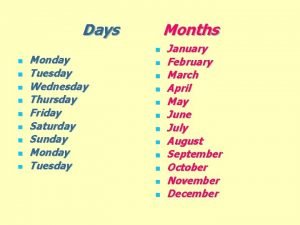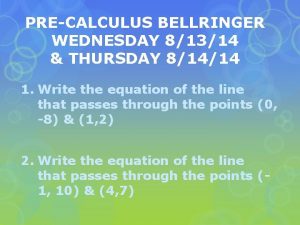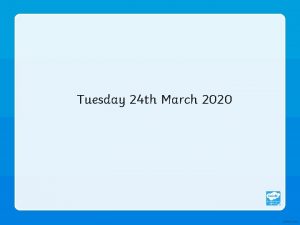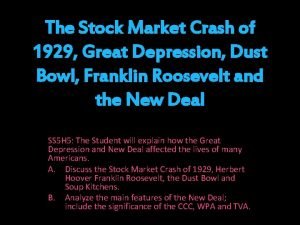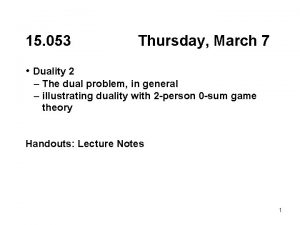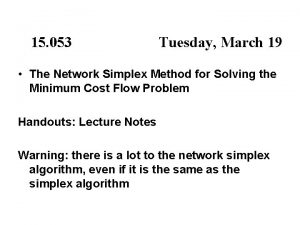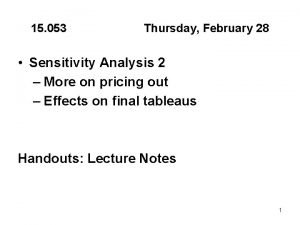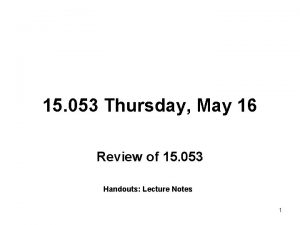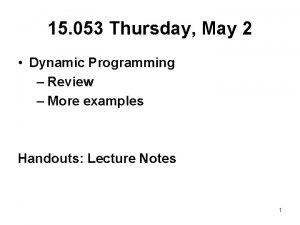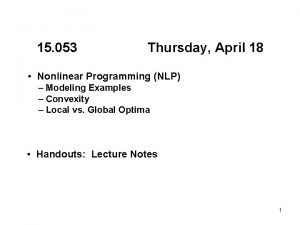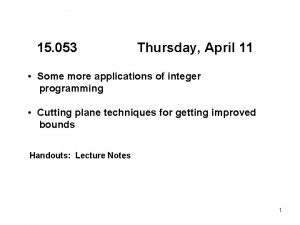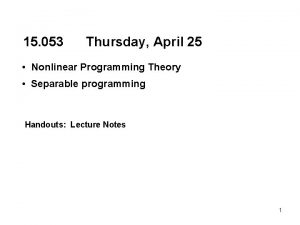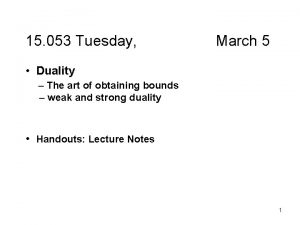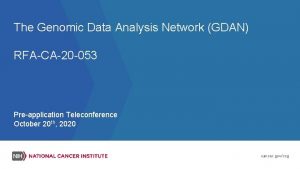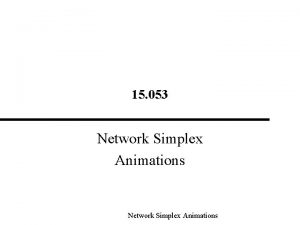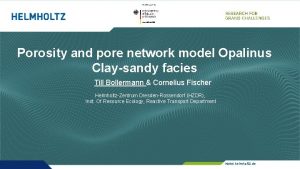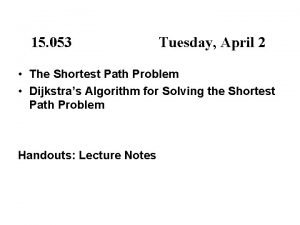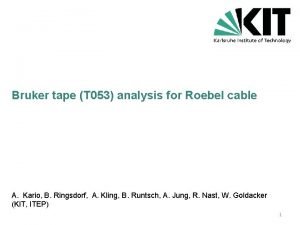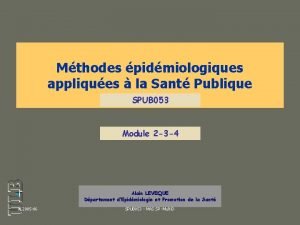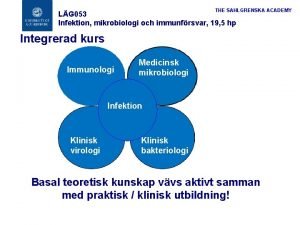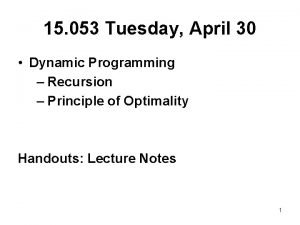15 053 Thursday March 14 Introduction to Network






























- Slides: 30

15. 053 Thursday, March 14 • Introduction to Network Flows • Handouts: Lecture Notes 1

Network Models • Linear Programming models that exhibit a very special structure • Can use this structure to dramatically reduce computational complexity • First widespread application of LP to problems of industrial logistics �� • Addresses huge number of diverse applications 2

Notation and Terminology Note: Network terminology is not (and never will be) standardized. The same concept may be denoted in many different ways. Called: • NETWORK • directed graph • digraph • graph Class Handouts (Ahuja, Magnanti, Orlin) Network G = (N, A) Node set N = {1, 2, 3, 4} Arc Set {(1, 2), (1, 3), (3, 2), (3, 4), (2, 4)} Also Seen Graph G = (V, E) Vertex set V = {1, 2, 3, 4} Edge set: A={1 -2, 1 -3, 3 -2, 3 -4, 2 -4} 3

Directed and Undirected Networks An Undirected Graph A Directed Graph • Networks are used to transport commodities • physical goods (products, liquids) • communication • electricity, etc. • The field of Network Optimization concerns optimization problems on networks 4

An Overview of Some Applications of Network Optimization Applications Physical analog of nodes Physical analog of arcs Communication systems phone exchanges, computers, transmission facilities, satellites Cables, fiber optic links, microwave relay links Voice messages, Data, Video transmissions Pipelines Water, Gas, Oil, Hydraulic fluids Wires Electrical current Flow Integrated computer circuits Pumping stations Reservoirs, Lakes Gates, registers, processors Mechanical systems Joints Rods, Beams, Springs Heat, Energy Transportation systems Intersections, Airports, Rail yards Highways, Airline routes Railbeds Passengers, freight, vehicles, operators Hydraulic systems 5

Examples of terms. Path: Example: 5, 2, 3, 4. (or 5, c, 2, b, 3, e, 4) Note that directions are ignored. Directed Path. Example: 1, 2, 3, 4 (or 1, a, 2, b, 3, e) Directions are important. Two paths a-b-e (or 1 -2 -3 -4) and a-c-d-e (or 1 -2 -5 -3 -4) Cycles (loops): a-b-c-d (or 1 -2 -3 -4 -1) b-a-d-c (or 3 -2 -1 -4 -3) e-b-a (or 1 -3 -2 -1) c-d-e (or 3 -4 -1 -3) Cycle or circuit (or loop) 1, 2, 3, 1. (or 1, a, 2, b, 3, e) Note that directions are ignored. Directed Cycle: (1, 2, 3, 4, 1) or 1, a, 2, b, 3, c, 4, d, 1 Directions are important. 6

More Definitions A network is connected if every node can be reached from every other node by following a sequence of arcs in which direction is ignored. A spanning tree is a connected subset of a network including all nodes, but containing no loops. 7

The Minimum Cost Flow Problem Network G = (N, A) – Node set N, arc set A; – Capacities uij on arc (i, j) – Cost cij on arc (i, j) – Supply/demand bi for node i. (Positive indicates supply) A network with costs, capacities, supplies, demands Minimize the cost of sending flow s. t. Flow out of i - Flow into i = bi Flow on arc (i, j) ≤ uij 8

The Minimum Cost Flow Problem Let xij be the flow on arc (i, j). Minimize the cost of sending flow s. t. Flow out of i - Flow into i = bi 0 ≤ xij ≤ uij Minimize s. t. for all i-j 9

Example Formulation Min s. t -3 x 12 + 8 x 13 + 7 x 23 + 3 x 24 + 2 x 34 x 12 + x 13 = 4 x 23+ x 24 - x 12 = 3 x 34 - x 13 - x 23 = -5 - x 24 - x 34 = -2 0 ≤ x 12 ≤ 6 0 ≤ x 13 ≤ 5 0 ≤ x 23 ≤ 2 0 ≤ x 24 ≤ 4 0 ≤ x 34 ≤ 7 10

An Application of the Minimum Cost Flow Problem Warehouses Plants Supplies Customers Demands Ship from suppliers to customers, possibly through warehouses, at minimum cost to meet demands. 11

Useful Facts About The Minimum Cost Flow Problem • Suppose the following properties of the constraint matrix, A (ignoring simple upper and lower variable bounds, such as x ≤ 7) hold: (1) all entries of A are 0 or 1 or -1 (2) there is at most one 1 in any column and at most one -1. • Then this is a minimum cost flow problem. 12

Useful Facts (cont’d) Theorem. If one carries out the simplex algorithm on the minimum cost flow problem with integer valued capacities and RHS, then at every iteration of the simplex algorithm, each coefficient in the tableau (except for costs and RHS) is either 0 or -1 or 1. Corollary. The optimal LP solution is integer valued. 13

The Minimum Cost Flow Problem Network G = (N, A) – Node set N, arc set A; – Capacities uij on arc (i, j) – Cost cij on arc (i, j) – Supply/demand bi for node i. (Positive indicates supply) A network with costs, capacities, supplies, demands Minimize the cost of sending flow s. t. Flow out of i - Flow into i = bi Flow on arc (i, j) ≤ uij 14

The Transportation Problem Suppose that one wants to ship from warehouses to retailers In this example: 3 warehouses 4 retailers ai is the supply at warehouse i. bj is the demand at retailer j. cij is the cost of shipping from i to j. There are no capacities on the arcs. Let xij be the amount of flow shipped from warehouse i to retailer j. How do we formulate an LP? 15

The Transportation Problem is a Min Cost Flow Problem Minimize the cost of sending flow s. t. Flow out of i - Flow into i = bi 0 ≤ xij ≤ uij Flow out occurs at the supply nodes. Flow in occurs at demand nodes. Capacities are infinite: uij= ∞ 16

The Transportation Problem In general the LP formulation is given as Minimize All arcs are from a node in S to a node in D, and uncapacitated. S: Supply nodes D: Demand nodes 17

Useful Facts About Transportation Problem Suppose that (1) the constraint matrix can be partitioned into A 1 x = b 1 and A 2 x = b 2. (2) all entries of A 1 and A 2 are 0 or 1 (3) there is at most one 1 in any column of A 1 or A 2 Then this is a transportation problem. Theorem. If one carries out the simplex algorithm on the transportation problem, then at every iteration of the simplex algorithm, each coefficient in the tableau (except for costs and RHS) is either 0 or -1 or 1. The costs and RHS are both integer valued. Corollary. The optimal solution to the LP is integer valued. 18

The Assignment Problem Suppose that one wants to assign tasks to persons Tasks Persons In this example: 4 tasks 3 persons No two tasks to the same person Each person gets a task cij is the “cost” of assigning task i to person j. Let xij = 1 if task i is assigned to j. Let xij = 0 otherwise. How do we formulate an LP? 19

The Assignment Problem In general the LP formulation is given as Minimize Each supply is 1 Each demand is 1 20

More on the Assignment Problem Tasks Persons The assignment problem is a special case of the transportation problem. The simplex algorithm can solve the LP relaxation, and it will give integer answers, that is, it will solve the assignment problem. 21

An Application of the Assignment Problem Suppose that there are moving targets in space. You can identify each target as a pixel on a radar screen. Given two successive pictures, identify how the targets have moved. 22

The Maximum Flow Problem Network G = (N, A). – Source s and sink t – Capacities uij on arc (i, j) – Variable: Flow xij on arc (i, j) Graph with capacities Maximize the flow leaving s s. t. Flow out of i - Flow into i = 0 for i ≠ s, t 0 ≤ xij ≤ uij 23

The Max Flow Problem In general the LP formulation is given as Minimize v otherwise This is not formulated as a special case of a minimum cost flow formulation. Can we reformulate it in this way? 24

More on the maximum flow problem Is the current flow optimal? An s-t cut is a separation of the nodes into two parts S and T, with s in S and t in T. The capacity of the cut is the sum of the capacities from S to T. Graph with capacities and flows (underlined) The max flow from s to t is at most the capacity of any s-t cut 25

The Shortest Path Problem What is the shortest path from an origin or source node (often denoted as s) to a destination or sink node, (often denoted as t)? What is the shortest path from node 1 to node 6? Assumptions for now: 1. There is a path from node s to all other nodes. 2. All arc lengths are non-negative 26

Direct Applications • What is the path with the shortest driving time from 77 Massachusetts Avenue to Boston City Hall? • What is the path from Building 7 to Building E 40 that minimizes the time spent outside? • �� What is the communication path from i to j that is the fastest (taking into account congestion at nodes)? 27

Formulation as a linear program In general the LP formulation is given as Minimize otherwise 28

The Shortest Path Problem �� • Fact: The Shortest path problem is a special case of the minimum cost flow problem • Lots of interesting applications (coming up) • Very fast algorithm (coming up) • Connection to dynamic programming (several lectures from now) 29

Conclusions. • Advantages of the transportation problem and the minimum cost flow problem – Integer solutions – Very fast solution methods – Extremely common in modeling • Today we saw the following: – The minimum cost flow problem – The transportation problem – The assignment problem – The maximum flow problem – The shortest path problem 30
 Poland national anthem lyrics
Poland national anthem lyrics Thoughtful thursday morning message
Thoughtful thursday morning message Monday tuesday wednesday thursday friday calendar
Monday tuesday wednesday thursday friday calendar Thursday night prayer
Thursday night prayer Holy thursday (songs of innocence)
Holy thursday (songs of innocence) Blessed holy thursday
Blessed holy thursday 997ni1xcmkw -site:youtube.com
997ni1xcmkw -site:youtube.com Today is thursday. the weather is
Today is thursday. the weather is Have a terrific thursday
Have a terrific thursday Thursday bell work
Thursday bell work Easter traditions in great britain
Easter traditions in great britain Thursday before easter
Thursday before easter Monday tuesday wednesday thursday friday saturday sunday
Monday tuesday wednesday thursday friday saturday sunday Thursday question of the day
Thursday question of the day Thursday bell ringer
Thursday bell ringer King forever
King forever Thursday prayer
Thursday prayer Thursday bell ringers
Thursday bell ringers Thursday bellringer
Thursday bellringer Welcome thursday
Welcome thursday Eugene kelly colgate
Eugene kelly colgate Science science science
Science science science Adjectives for tuesday
Adjectives for tuesday Oeoes uc davis
Oeoes uc davis Thursday 420
Thursday 420 Dua for thursday
Dua for thursday Romeo juliet
Romeo juliet Wednesday-saturday
Wednesday-saturday Senior g friendship thursday
Senior g friendship thursday Welcome thursday
Welcome thursday Black thursday
Black thursday












